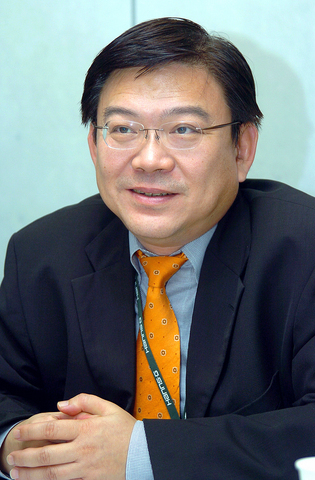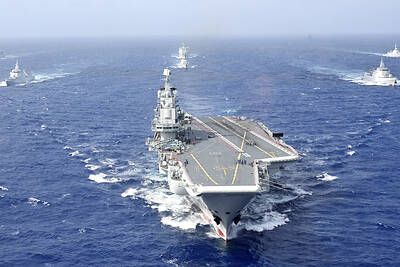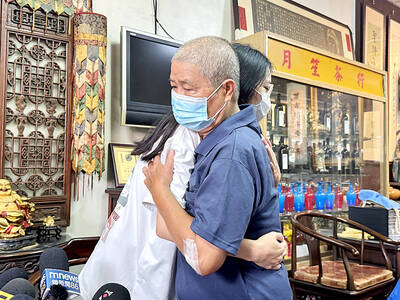Taipei Times: Why hasn't HannStar seen mergers as a quick fix to the heavy losses it suffered in the past nine quarters due to oversupply?
David Chou (
HannStar has already dealt with its most important problems in terms of financial status. The company will be able to fully reverse its past [unimpressive] operations, provided we make the right decisions about product strategies and the size of a new cost-effective plant. I don't think it is appropriate to enter any merger talks with any company at the moment, as mergers may cause more uncertainties.

PHOTO: LU CHUN-WEI, TAIPEI TIMES
HannStar has reduced its debt ratio to around 39 percent and we now hope to drive that figure down further to 33 percent by the end of the year and to more than 10 percent next year by paying back more debts. Our debt ratio is much lower than our bigger rivals. [AU Optronics Corp (
While getting rid of its financial burden, HannStar saw a good chance to pick up growth momentum and reverse its past operational trough. Now we use most of our capacity in making 19-inch, 17-inch-widescreen and 28-inch-widescreen panels, for which HannStar has the lowest cost compared to its competitors.
Besides, we are also carefully evaluating building a cost-effective next-generation factory [to broaden our product portfolio. Now the biggest screen made by HannStar is the 28-inch panel used in monitors that are equipped with TV turners.]
TT: HannStar has been talking about cooperation with other Taiwanese liquid-crystal-display (LCD) panel makers to minimize the impact of price declines on overcapacity. Can you elaborate on that?
Chou: We made substantial progress by cooperating with Chunghwa Picture Tubes Ltd (中華映管) in assembling panels in China. To be specific, we swap capacities to cater to our needs. HannStar swapped 19-inch modules for Chunghwa Picture's 17-inch modules, which HannStar can assemble to make slim screens for our brand-name Hanns G (瀚視奇), computer monitors.
TT: Do you worry about Innolux Display Corp (
Chou: Not in the least. I think HannStar will benefit from Innolux's growth, as Innolux is one of our customers.
Innolux buys 17-inch panels from HannStar so HannStar can grow along with Innolux's expansion as the company will not change its policy of sourcing half of the panels it needs from outside suppliers and half made in its factories.
HannStar is also in talks with Innolux to supply 19-inch panels. As such, we only directly compete with Innolux in the area of 7-inch flat panels.
TT: HannStar is halfway into designing a next-generation plant in Tainan. Does HannStar have any plans to resume construction anytime soon?
Chou: Hopefully, we will restart the project next year. But that will be in accordance with the growth in our own-brand monitors. HannStar makes the equivalent of 14 million 19-inch panels a year at its fifth generation (5G) plant; more than a third are for our own monitors.
The optimal situation will be half of our capacity used for our own brand-name products and half for other companies.
We believe it will be a proper time for us to restart the construction after the shipment of branded computer monitors grows to 6 million units a year. That will take a long time. This year, we expect to ship 4 million units.
TT: Some 90 percent of HannStar's production is 19-inch monitor panels. What is HannStar's roadmap for getting a share of the fast-growing LCD TV market?
Chou: The LCD TV market is attractive as the growth is fast, but most companies making TV panels are losing money due to high capacity expansion.
We are interested in making bigger-than 40-inch TV panels such as 47-inch or even 52-inch panels, but we're skipping 32-inch and 37-inch panels on cost efficiency. Most companies operating sixth-generation (6G) plants, which are used to cut 32-inch and 37-inch TV panels, are losing money and they do not know when they will be able to earn money from those plants.
We are also trying to determine which types of factories will give us an edge in manufacturing cost. We are evaluating all possibilities, including building a 7.5-generation, 7.8-generation, or eighth-generation plant.
Learning from past experience, we have to be very careful this time as the investment is huge: around NT$50 billion [US$1.52 billion] to NT$60 billion. Before making any substantial move, we have to be sure the factory will be profitable. We cannot afford another misstep.
In addition to the cost issue, we are also trying to expand our brand business since this is another channel where we can digest our capacity.
TT: Brand business currently accounts for more than 14 percent of HannStar's total business this year. What forces were at play to push the company to create its own brands, Hannspree (
Chou: We started thinking about having our own brand two or three years ago after HannStar had encountered heavy losses during the past three crystal cycles.
HannStar suffered during the overcapacity-driven industry downturn as customers, including computer giant Dell Inc, were requesting lower prices.
To minimize price erosion by speeding up the flexibility in price changes in the end market, our chairman Chiao Yu-chi (
The concept is similar to Dell's direct sales. Since we can adjust our monitor prices [to spur demand] as soon as the price of panels drops, this will help us digest panel inventory more rapidly. In the past, HannStar had to book two to three months worth of inventory losses in the warehouse, which severely impacted our bottom line.
So brand-name business means a lot for HannStar in the highly volatile flat-panel industry. In an industrial downturn, branded products will be an important channel for HannStar to sell panels, which will help us reduce the impact of price erosion.
TT: How has the new brand business been doing?
Chou: We expect shipments of computer monitors to double next year. This year, we aim to ship 1.8 million Hanns G monitors, with the strongest growth occurring in Europe.
HannStar was ranked the No. 9 monitor vendor in Western Europe, up from No. 12 in the second quarter of the year. We started marketing Hanns G products in mid-April.
This is a remarkable performance as it only took 8 months for us to squeeze into the top 10. We hope to climb to No. 3, or No. 4, in the short term.
Europe now accounts for 60 percent of our overall brand business in terms of revenue. We expect the percentage to rise to 70 percent next year.
TT: Market researcher DisplaySearch forecast panel supply may exceed demand by 20 percent in the first quarter of next year. The research house strongly suggested panel makers cut production to avert drastic price decline. Will HannStar consider trimming factory usage to cope with the possible glut?
Chou: I believe the possibility will be slim, as our brand business will consume more than 30 percent of our total production. As a result, I do not think it is necessary for us to trim output now.
Besides, big panel makers are facing greater pressure than us because of heavy financial burdens. As we know, AU Optronics is lowering factory usage now. That will be good for the industry in general.

A Chinese aircraft carrier group entered Japan’s economic waters over the weekend, before exiting to conduct drills involving fighter jets, the Japanese Ministry of Defense said yesterday. The Liaoning aircraft carrier, two missile destroyers and one fast combat supply ship sailed about 300km southwest of Japan’s easternmost island of Minamitori on Saturday, a ministry statement said. It was the first time a Chinese aircraft carrier had entered that part of Japan’s exclusive economic zone (EEZ), a ministry spokesman said. “We think the Chinese military is trying to improve its operational capability and ability to conduct operations in distant areas,” the spokesman said. China’s growing

Nine retired generals from Taiwan, Japan and the US have been invited to participate in a tabletop exercise hosted by the Taipei School of Economics and Political Science Foundation tomorrow and Wednesday that simulates a potential Chinese invasion of Taiwan in 2030, the foundation said yesterday. The five retired Taiwanese generals would include retired admiral Lee Hsi-min (李喜明), joined by retired US Navy admiral Michael Mullen and former chief of staff of the Japan Self-Defense Forces general Shigeru Iwasaki, it said. The simulation aims to offer strategic insights into regional security and peace in the Taiwan Strait, it added. Foundation chair Huang Huang-hsiung

PUBLIC WARNING: The two students had been tricked into going to Hong Kong for a ‘high-paying’ job, which sent them to a scam center in Cambodia Police warned the public not to trust job advertisements touting high pay abroad following the return of two college students over the weekend who had been trafficked and forced to work at a cyberscam center in Cambodia. The two victims, surnamed Lee (李), 18, and Lin (林), 19, were interviewed by police after landing in Taiwan on Saturday. Taichung’s Chingshui Police Precinct said in a statement yesterday that the two students are good friends, and Lin had suspended her studies after seeing the ad promising good pay to work in Hong Kong. Lee’s grandfather on Thursday reported to police that Lee had sent

BUILDUP: US General Dan Caine said Chinese military maneuvers are not routine exercises, but instead are ‘rehearsals for a forced unification’ with Taiwan China poses an increasingly aggressive threat to the US and deterring Beijing is the Pentagon’s top regional priority amid its rapid military buildup and invasion drills near Taiwan, US Secretary of Defense Pete Hegseth said on Tuesday. “Our pacing threat is communist China,” Hegseth told the US House of Representatives Appropriations Subcommittee on Defense during an oversight hearing with US General Dan Caine, chairman of the Joint Chiefs of Staff. “Beijing is preparing for war in the Indo-Pacific as part of its broader strategy to dominate that region and then the world,” Hegseth said, adding that if it succeeds, it could derail